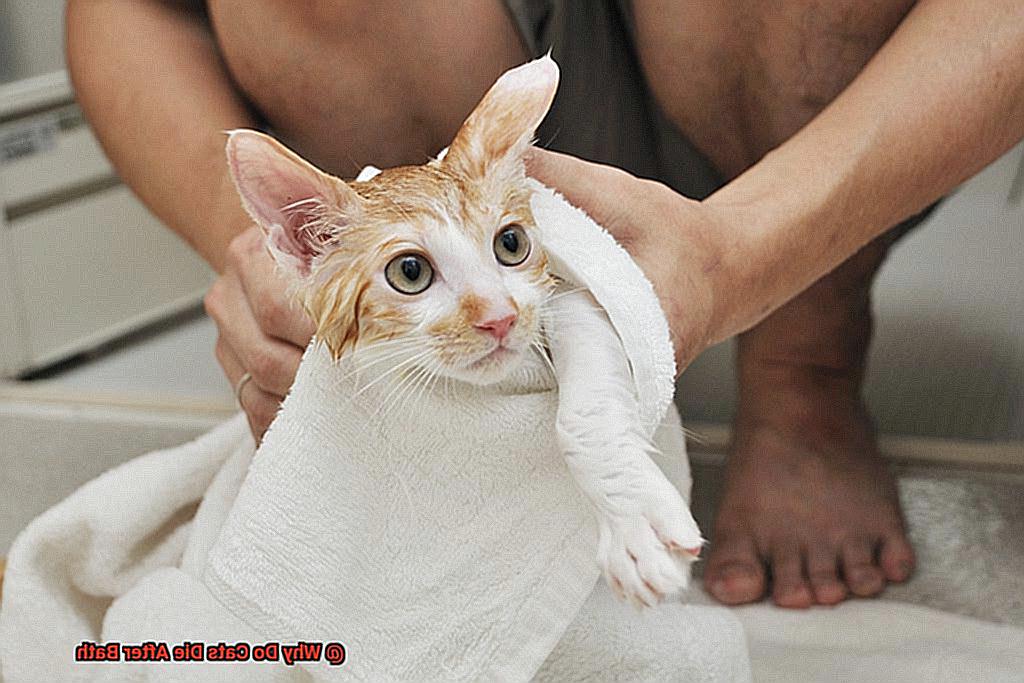Do you love your cat, but dread bath time? You may have heard horror stories about cats dying after baths. Although this is rare, it’s still possible.
It’s important to know why and how to keep your cat safe.
Here, we’ll discuss why cats die after baths and how to prevent accidents. We’ll also talk about the importance of knowing your cat’s needs and finding the right bathing products for them.
Cats are not naturally fond of water. Exposure can cause serious health issues like heart disease or death.
A sudden temperature change – like stepping into a cold bathtub – can also cause shock in cats. Drowning is another common cause of death after a bath.
Cats can slip under the water’s surface while trying to escape, or cry and leap out of their owner’s arms during bathing. Owners must keep a close eye on their pets at all times during bathtime and never leave them unattended in the tub.
Some medical disorders make cats more vulnerable during bath time too. For example, cats with heart disease may suffer cardiac arrest due to exhaustion or overexertion; felines with respiratory problems may have difficulty breathing in wet conditions.
By understanding why cats die after baths and taking precautions, you can make sure that bath time is safe and enjoyable for both you and your furry friend.
What is Hypothermia?
Hypothermia is a dangerous medical condition that can be life-threatening to cats, particularly after taking a bath.
It occurs when the body temperature of a cat drops below the recommended range of 100.5°F to 102.5°F and can lead to serious health issues such as shivering, lethargy, and loss of consciousness. When cats take a bath, their coat becomes wet which causes rapid heat loss from the cat’s body.
Furthermore, cats groom themselves with self-cleaning oils that get washed away if they get wet. This reduces the insulation capacity of their fur coats and makes them more vulnerable to hypothermia.
Cats that are older or have underlying medical disorders are at an increased risk of developing hypothermia after a bath. To prevent this, it is essential to ensure cats are completely dry after their bath and not exposed to cold environments until they are dry.
Additionally, make sure they are not bathing their cats too often and use warm water during baths.
How Does a Cat Get Hypothermia After a Bath?
Cats are incredibly susceptible to hypothermia after a bath, as the moisture on their fur acts as a conductor of heat, causing their body temperature to drop rapidly.

Older or unwell cats are especially vulnerable, and if left untreated, hypothermia can be fatal. To protect your feline friend from this risk, it’s essential to fully dry them off and keep them warm.
Using a towel or hairdryer on a low-heat setting is the best way to remove excess moisture from your cat’s fur. Be sure to keep the hairdryer at a safe distance so you don’t burn their skin.
Identifying Cats at Risk of Hypothermia After a Bath
Cats are unique creatures that can be quite sensitive to temperature changes, and one of the risks they face after taking a bath is hypothermia.
This condition occurs when the cat’s body temperature drops below normal levels and can be life-threatening, so it’s essential to identify cats at risk of hypothermia after a bath. Cats with preexisting medical conditions, such as diabetes, thyroid problems, or heart diseases, are more likely to experience hypothermia after a bath.

Age, size, and the thickness of the cat’s fur can also affect its ability to regulate its body temperature, making some cats more vulnerable than others. The water temperature during the bath should also be taken into consideration.

The water should be warm – not hot or cold – and should be similar to the cat’s body temperature (around 101°F/38°C). Cats that are anxious or stressed during a bath may also be at risk of hypothermia due to their inability to groom themselves properly afterward.
Preventing Hypothermia in Cats After a Bath
It is our responsibility to take all necessary steps to ensure our furry friends remain safe and healthy.
Giving them a bath may seem like a straightforward task, but if not done correctly, it can quickly become a life-threatening situation. Cats are delicate creatures, and their body temperature regulation can be easily affected by factors such as age, breed, and fur thickness.
They are particularly vulnerable to hypothermia after a bath, so what can we do to prevent this? First and foremost, drying your cat thoroughly is key.
Towel-drying alone isn’t enough to remove all the moisture from their fur – you need to use a hairdryer on the lowest setting and hold it at least 6-8 inches away from your cat’s fur. To avoid any burns or discomfort, keep the hairdryer moving continuously.
Additionally, keeping your cat in a warm and dry environment after a bath is also essential. Avoid taking them outside or allowing them to sit near a doggy door because the cold air will trigger hypothermia even further.
To prevent heat loss after a bath, you can drape a warm blanket or towel over them. Furthermore, keep an eye out for signs of hypothermia such as shivering, lethargy, and muscle stiffness after their bath.
Drying Your Cat After a Bath
The importance of properly drying your cat after a bath cannot be overstated.
Leaving them wet can lead to hypothermia, which can be fatal if not treated immediately. To ensure your cat’s safety and health, follow these tips for drying them off.
Start by using a soft towel to gently blot away as much water as possible. Rubbing the fur with a towel may cause knots and mats, so it’s best to blot instead.
You can also use a hairdryer on the lowest heat setting or a pet dryer designed for cats. Just keep the dryer at a safe distance from their skin to avoid any potential burns.
Never leave your cat to air dry after bathing them. This could result in hypothermia, or even secondary drowning or aspiration pneumonia if they drink too much water while grooming themselves.
Creating a calm environment is key when bathing your cat; lower noise levels and speak in soothing tones throughout the entire process.
How Often Should You Bathe Your Cat?
Cats are generally self-cleaning animals, but there may be times when a bath is necessary. The frequency of baths will depend on a variety of factors such as your cat’s age, breed, and lifestyle.
It is typically recommended to bathe your cat every 4-6 weeks or as needed. Safety is key when it comes to bathing cats.
To avoid any potential risks, use lukewarm water to wet their fur and keep their face and ears away from the water. Gently apply the shampoo and rinse thoroughly until all the shampoo has been washed away.
Once they’re clean, pat them dry with a towel or allow them to air dry in a warm room until they’re completely dry. It is important to note that cats have different pH levels than humans, so human shampoos should be avoided at all costs.
Using these can upset their skin balance, causing irritation and dryness. Additionally, hairdryers should never be used as their noise and heat can traumatize your cat.
Signs and Symptoms of Hypothermia in Cats
Hypothermia in cats is a potentially life-threatening condition which can be caused by prolonged exposure to cold temperatures or wet fur.
It is essential to recognize the signs and symptoms of hypothermia in cats, such as shivering, lethargy, pale gums, low body temperature, and decreased heart rate. When bathing your cat, it is important to take precautions to avoid hypothermia.
Use lukewarm water and ensure that they are dried thoroughly afterward. Depending on the breed of the cat and the thickness of their coat, you may need to use a towel to gently blot their fur and remove excess water.
Avoid using hairdryers as it can burn their skin. If you suspect that your cat has hypothermia, take them immediately to the vet for proper treatment.
In the meantime, keep them warm by wrapping them in a blanket and offer them a warm drink such as diluted chicken broth.
dHw7O_cQ9KU” >
Treatment for Hypothermia in Cats
Hypothermia is a serious condition that can occur in cats when they are exposed to cold water during a bath or in cold weather conditions.
If your cat has hypothermia, it is important to act quickly and take the necessary steps to warm them up safely. The first step is to wrap your cat in a warm towel or blanket and move them to a warm room.
You can also use a heating pad, but make sure to set it on a low setting and place it under the towel or blanket for added protection. Monitor your cat’s temperature with a rectal thermometer every 10-15 minutes until their temperature reaches the normal range of 100.5°F-102.5°F.
If their temperature falls below 95°F, take them to the vet immediately for medical attention. In order to prevent hypothermia from occurring in cats, it is important to take preventive measures such as giving your cat lukewarm baths and keeping them indoors during cold weather conditions.
Make sure you dry them off thoroughly after bathing and avoid using hair dryers as this could cause further complications.
Also Read: Why Does My Cat Drink My Bath Water?
Conclusion
Caring for cats requires special attention, especially when it comes to bath time.
Knowing why cats die after baths and how to avoid accidents is essential. Hypothermia is a serious medical disorder that can be life-threatening, so it’s important to take the appropriate steps to keep your cat safe and healthy.
Ensure thorough drying of your cat after their bath – towel-drying alone won’t do the job. Use a hairdryer or a pet dryer at least 6-8 inches away from their skin.
Additionally, keep them in a hot and humid environment until they are totally dry. Cats with preexisting medical issues such as diabetes or heart disease are more likely to experience hypothermia after bathing.
If you suspect your cat has hypothermia, rush them to the hospital for proper care and wrap them in a warm blanket while giving them a warm drink like diluted chicken broth.







